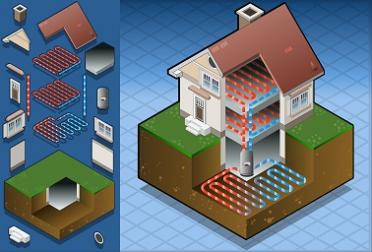
Did you know that almost two-thirds of the electricity bill is spent heating and cooling your home? With temperature fluctuations that range from mild to extreme in some areas of the country, it should come as no surprise. Lowering that energy consumption while maintain a level of comfort within the home is the goal of geothermal energy.
What is Geothermal Energy?
As the name implies, geothermal energy is energy originating from the earth. While the temperatures above ground fluctuate continuously based on season and other weather conditions, the temperatures below the surface of the earth remain fairly constant. In most areas, that temperature is around 55 degrees most days. This is due to the earth absorbing about 40 percent of the heat that is reflected onto the earth’s surface each day. It may not feel like 55 degrees to the touch but that harnessed energy is there begging to be used.
This energy can be used to heat and cool your home. How, you say? Through the use of heat pumps that run on geothermal energy. Regular heat pumps pull heat from the air to heat or cool your home. Traditional heating and cooling devices do the same. The problem comes in when the temperatures outside are not cooperating with your technology.
Here’s an example. If a heat pump is trying to cool your home, it will pull heat from the inside and pump it outside. When the outside air is warmer than inside your home, the air is less likely to accept more heat, meaning the pump will have to work harder to deliver comfortable cool air. On the flip side, when the pump is extracting heat from the outside air and bringing it inside to warm the home, that can become a problem if the outside temperatures are near freezing. In both cases, the efficiency is lower when you need it to be higher.
How does Geothermal Energy Work?
A geothermal heat pump utilizes the energy from the ground through an “earth loop.” Polyethylene piping is laid below ground. A water-based coolant flows through the pipes to absorb or release heat into the earth depending on your needs. Piping is laid either horizontally, vertically or in coils at the bottom of a body of water. It is all dependent on your property dimensions.
During the winter months, the heat pump collects stored heat from the earth into the pipes and it is circulated throughout ductwork within your home. During the summer, heat is removed from the home and distributed to the earth. Cooler fluid is looped back into the home. This system works much like a refrigerator does.
Geothermal heating is expensive. Drilling has to be done to lay piping and install the units underground and within your home. Once it is operational, you will find you are enjoying a durable, quiet and comfortable way to heat and cool your home for years to come.

